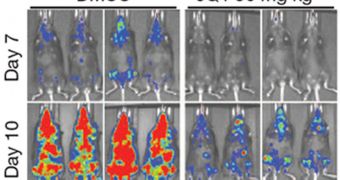A collaboration of six universities and research centers has taken an unorthodox approach to searching for drugs that may combat a fierce type of blood cancer, called acute myeloid leukemia. The work has already discovered a potent drug candidate.
The research team, which also included investigators from the Cold Spring Harbor Laboratory (CSHL), says that treating this condition could prevent 1.2 percent of all cancer deaths in the United States.
AML is characterized by the rapid growth of abnormal white blood cells in the body. They accumulate in the bone marrow, where they interfere with the normal production patterns of blood cells. The condition mostly affects adults, and chances of developing it grow with age.
Doctors can presently cure only about 30 percent of AML cases, with the remaining 70 percent being fatal to patients. Experts say that the new protein they discovered – called Brd4 – may be used as a means of counteracting the effects of this type of leukemia.
The molecule has been identified as a new target of treatment, which means that now investigators will begin to develop medication that will target it specifically, for maximum effect. However, even if work on this begins this year, a few years will still pass before a cure is made readily available.
Details of the research efforts and its conclusions appear in the August 3 issue of the top scientific journal Nature. The work explains how the team was able to cure AML in unsuspecting lab mice that had been genetically-conditioned to develop it.
The researchers created a compound that inhibited the activity of the Brd4 protein once injected in the body. Mice that had the disease exhibited a significant reduction in abnormal blood cells count only 7 days after therapy began.
“The drug candidate not only displays remarkable anti-leukemia activity in aggressive disease models and against cells derived from patients with diverse, genetic subtypes of AML, but is also minimally toxic to non-cancerous cells,” Chris Vakoc, MD, PhD, says.
He holds an appointment as a research scientist at CSHL, and was also the leader of the research team. The expert adds that a drug is already being developed for therapeutic use for cancer patients by the company Tensha Therapeutics. Clinical trials could begin within two years.
“The success of this approach also points to the strength of the cancer research program at CSHL where our researchers efforts in uncovering information about what drives individual cancers in patients is being rapidly translated into developing novel therapeutics that can immediately benefit patients in the clinic,” CSHL President Bruce Stillman, PhD, concludes.

 14 DAY TRIAL //
14 DAY TRIAL //